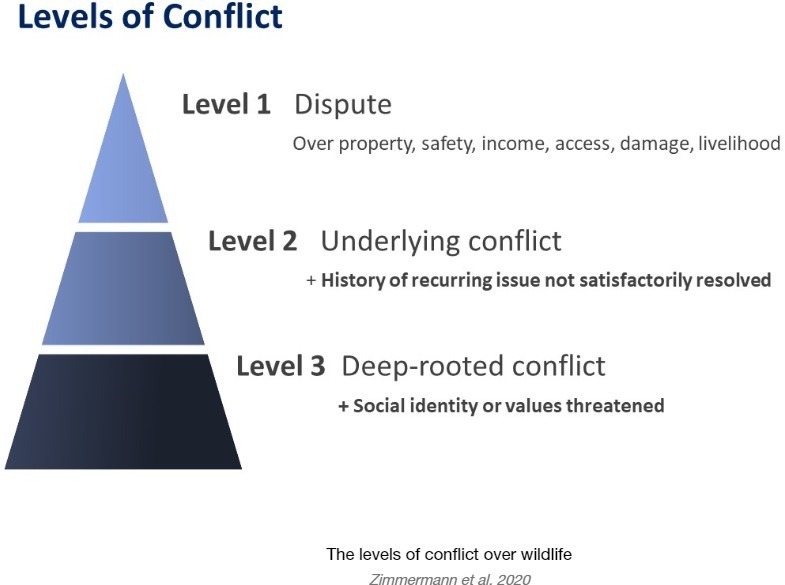21 Feb 2023 Human-wildlife conflicts in India
Human-wildlife conflicts in India
India is a country with diverse natural resources and livestock. It’s a living example of how life, in all its forms, survives in synchronization to yield megadiversity centers on the earth. However, in this land of co-existence, there are rising incidences of human-wildlife conflict that make headlines frequently. Recently, the elephant calf was rehabilitated in the deep forest after a large-scale protest was staged by locals in Karnataka.
What is human-wildlife conflict?
Wildlife can create a threat to the survival of human life and property when there happens to be an overlap. Either due to the active intrusion of man into the habitats of wild animals or
characteristics of some wildlife species which force them to enter into human habitation make this issue conflicting.
Traditionally, co-existing species now are at crossroads against one another is a threat to peaceful and sustainable development. Level of Conflict Based on the nature and intensity of interaction and later conflict, Human-wildlife conflict can be staged into three levels as

human-wildlife conflict
These levels are indicative of increasing conflict and fewer possibilities for coexistence.
Relevant Data
- Between 2018-19 and 2020-21, 222 elephants were electrocuted around the nation.
- Also, 197 tiger fatalities are being investigated, while 29 tigers were murdered by poachers between 2019 and 2021.
- Elephants murdered 1,579 people in three years, including 585 in 2019–20, 461 in 2020–21, and 533 in 2021–22, as a result of conflicts with the creatures.
- With 332, Odisha had the most fatalities, followed by Jharkhand (291), West Bengal (240), and then Jharkhand.
What are the causes of rising Human-wildlife conflict?
- Natural reasons include Nature and characteristics of species which make it to follow large distances or migration. For example, elephant tracks cover a large corridor for
- Changing food habits and ecosystem imbalances create issues such as the non-availability of prey or mating partners.
Manmade reasons
- Habitat fragmentation is the most significant issue that has separated biotic communities and forced animals to cross human habitation frequently.
- Decreasing forest cover, which makes the overlap between humans and wildlife more
common and regular. The best example is Karnataka, which has seen a surge in conflicts in recent years. The total area under forest cover was 43,356 square kilometers, or 22.61% of the state’s area, which shrank by 4059 square kilometers or remained at 21.16% of the overall area in 2021–22.
- Changing crop patterns attract wild animals to human residences, like monkeys in Uttarakhand, which significantly damages crop productivity as well.
- Man-made disasters like forest fires, deforestation, etc. make the intrusion much more
- Noise pollution, air pollution, and other forms of ecosystem imbalance impact the psychological balance of wildlife and make penetrations frequent and common.
What needs to be done?
- The issue is widespread, and almost every corner of the country is experiencing it in various intensities.
- The need is to reaccess the biotic system and change the roles of species, which is at the root of this cause. Understanding species dynamics and nature will help us possibly reach the status of peaceful co-existence.
- The development need is, no doubt, unavoidable, but it must keep pace with the ecosystem’s requirements and balance.
- The decline in forest cover needs to control and rather to enhance overall forest That will ensure habitat for survival and the availability of prey for the animals, and thus overlapping zones can be minimized.
- Local participation to deal with such crucial conflict is very Every instance of conflict is different and unique, so it needs a locally sustainable strategy to work and be implemented. Even so, locals are the first point of contact where conflict arises, and better training would reduce the risk of escalation.
- Technological deterrents like Project Honeybee, wildlife-repellent cropping patterns, pit or linear ridges, and building eco-bridges and eco-tunnels should be integrated into every forest infrastructure project.
Human-wildlife conflict is an indicator of slipping through the cracks. There is a neglect of the principles of mutual coexistence and ecosystem sustainability. The state and society must adhere to development without neglecting an inclusive and sustainable development approach. That seems to be the only immediate solution in sight.
YOJNA IAS DAILY CURRENT AFFAIRS ENG MED 21th FEB
Source:
Get the Latest Current Affairs from Yojna IAS


No Comments